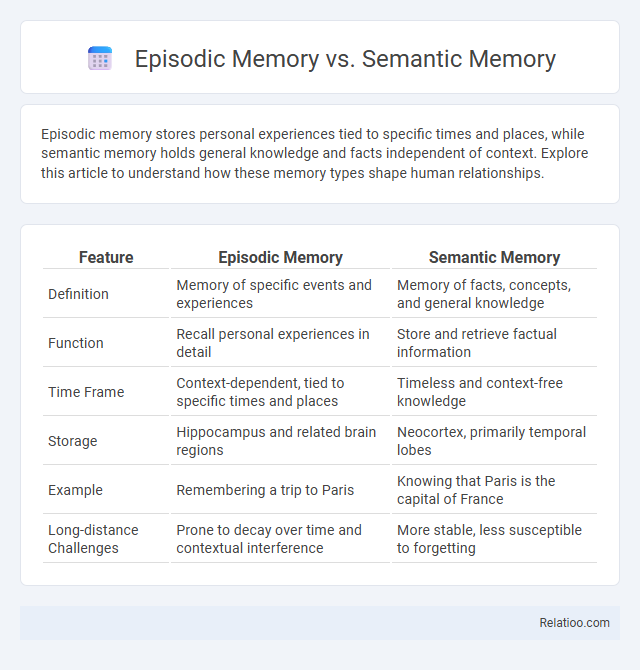Episodic memory stores personal experiences tied to specific times and places, while semantic memory holds general knowledge and facts independent of context. Explore this article to understand how these memory types shape human relationships.
Table of Comparison
| Feature | Episodic Memory | Semantic Memory |
|---|---|---|
| Definition | Memory of specific events and experiences | Memory of facts, concepts, and general knowledge |
| Function | Recall personal experiences in detail | Store and retrieve factual information |
| Time Frame | Context-dependent, tied to specific times and places | Timeless and context-free knowledge |
| Storage | Hippocampus and related brain regions | Neocortex, primarily temporal lobes |
| Example | Remembering a trip to Paris | Knowing that Paris is the capital of France |
| Long-distance Challenges | Prone to decay over time and contextual interference | More stable, less susceptible to forgetting |
Understanding Episodic Memory
Episodic memory refers to the ability to recall specific events, experiences, and situations from one's personal past, including contextual details like time and place. Unlike semantic memory, which stores general knowledge and facts independent of personal experience, episodic memory is tied to the individual's subjective experience and temporal context. Understanding episodic memory is crucial for studying how humans reconstruct past events and maintain a coherent sense of self over time.
Exploring Semantic Memory
Semantic memory is a critical component of long-term memory that stores general world knowledge, facts, concepts, and meanings independent of personal experience. Unlike episodic memory, which records specific events and experiences, semantic memory enables the understanding of language, the use of symbols, and the retrieval of factual information such as vocabulary and historical dates. Exploring semantic memory reveals its foundational role in cognitive processes like reasoning, comprehension, and knowledge organization.
Key Differences Between Episodic and Semantic Memory
Episodic memory stores personal experiences tied to specific times and places, allowing You to recall events and emotions vividly. Semantic memory, in contrast, holds general knowledge and facts independent of personal experience, such as vocabulary or world concepts. The key difference lies in episodic memory's connection to autobiographical context, while semantic memory concerns abstract, decontextualized information.
Brain Structures Involved in Each Memory Type
Episodic memory primarily relies on the hippocampus and medial temporal lobes to encode and retrieve personal experiences linked to specific times and places. Semantic memory engages the lateral temporal cortex and regions within the anterior temporal lobe, supporting the storage of general knowledge and facts detached from personal context. Your brain utilizes these distinct structures in coordination with the prefrontal cortex, which oversees memory consolidation and retrieval across both episodic and semantic domains.
Examples of Episodic Memory in Everyday Life
Episodic memory involves recalling specific events from your personal past, such as remembering your last birthday celebration or the details of a recent vacation. Semantic memory stores general knowledge and facts, like knowing the capital of France, while memory as a whole encompasses both types alongside procedural memory for skills. You rely on episodic memory every time you vividly retrace a meaningful conversation or a unique experience.
Real-World Applications of Semantic Memory
Semantic memory enables you to understand and apply general world knowledge, such as vocabulary, facts, and concepts, in everyday tasks like language comprehension, decision-making, and problem-solving. Unlike episodic memory, which stores personal experiences, semantic memory supports activities like reading, learning new skills, and navigating social interactions by providing a structured framework of information. Real-world applications of semantic memory include enhancing artificial intelligence systems, improving educational methods, and aiding brain injury rehabilitation through targeted cognitive exercises.
How Episodic and Semantic Memory Interact
Episodic memory stores personal experiences and specific events with contextual details, while semantic memory holds general world knowledge and facts independent of time and place. These two memory systems interact when episodic memories contribute to the formation and updating of semantic memory by integrating new information from personal experiences into existing cognitive schemas. This dynamic interplay enables flexible retrieval and the enrichment of knowledge, supporting complex reasoning and learning processes.
The Role of Memory in Learning and Education
Episodic memory stores personal experiences tied to specific times and places, enabling learners to recall past learning contexts and apply knowledge effectively. Semantic memory involves the storage of general knowledge and facts, forming the foundation for understanding new information and building complex concepts in education. Both forms of memory interact within cognitive processes, enhancing learning outcomes by allowing the integration of contextual experiences with factual information.
Memory Disorders: Impacts on Episodic vs Semantic Memory
Memory disorders distinctly affect episodic and semantic memory, with episodic memory often impaired in Alzheimer's disease, leading to difficulties recalling personal events and experiences. Semantic memory degradation is common in semantic dementia, causing problems with understanding meanings, concepts, and general knowledge. Differentiating these impacts aids in diagnosing specific neurodegenerative conditions and tailoring cognitive interventions effectively.
Strategies to Improve Episodic and Semantic Memory
Techniques to enhance episodic memory include visualization, vivid sensory detail encoding, and mental time travel exercises, which strengthen personal event recall. Semantic memory improves through elaborative rehearsal, concept mapping, and the use of mnemonic devices, fostering better retention of facts and general knowledge. Regular cognitive activities such as reading, storytelling, and engaging in discussions support both episodic and semantic memory by promoting neural connectivity and information integration.

Infographic: Episodic Memory vs Semantic Memory
 relatioo.com
relatioo.com